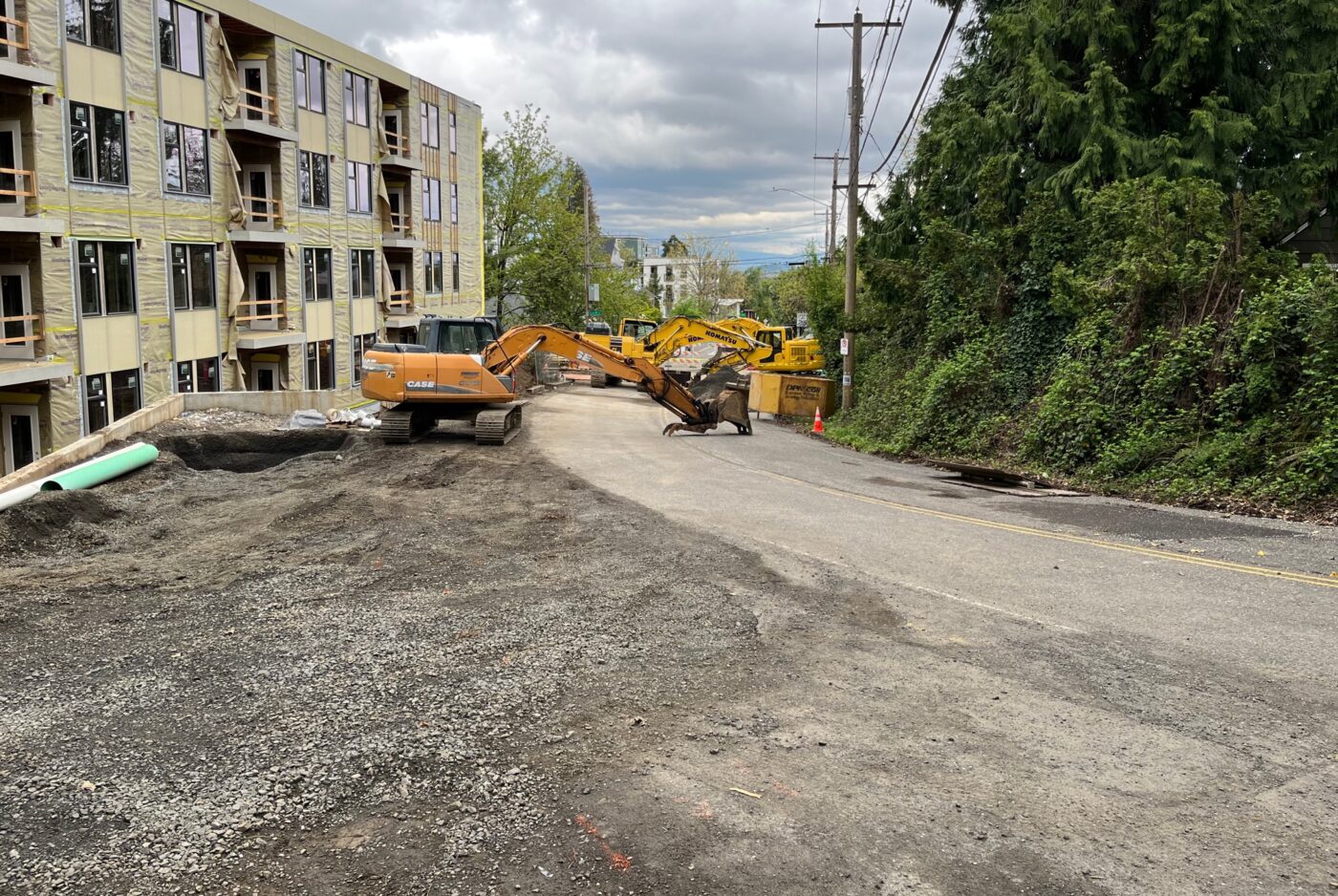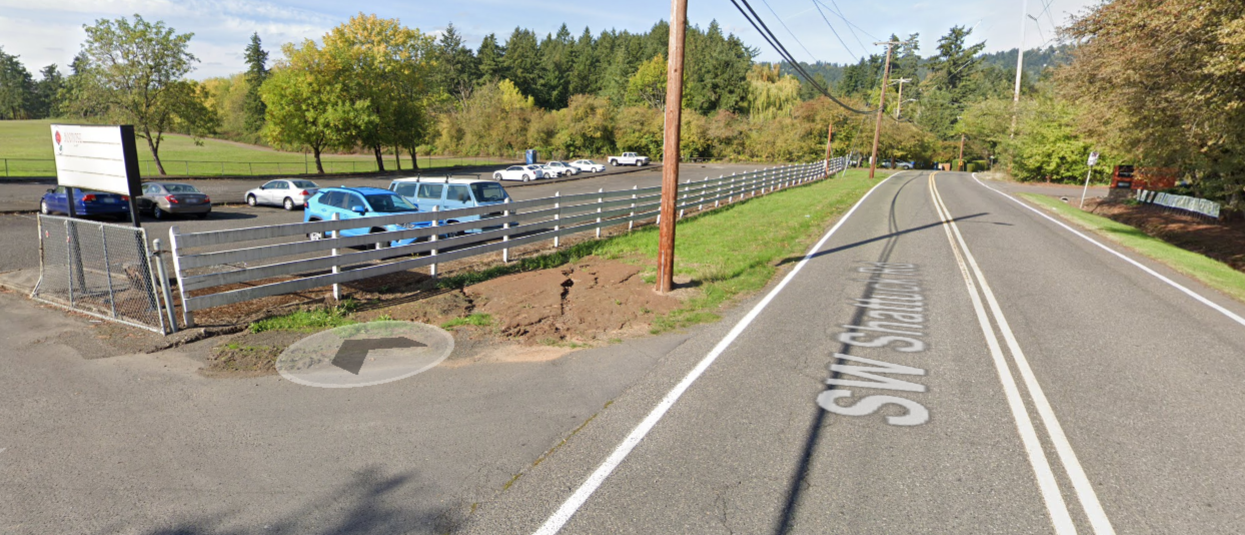
Nowhere to Walk on SW Gibbs
Previous stories in this series:
Last week I received an email from longtime southwest Portland trail activist Don Baack, who has been concerned that a protected pedestrian walkway wasn’t required along the frontage of a new apartment building under construction on Southwest Gibbs St.
Baack had contacted the office of Commissioner Mingus Mapps to learn more about the reasoning behind the Portland Bureau of Transportation’s decision to have pedestrians walk in the road, between the fog line and a guardrail. (Mapps is the commissioner-in-charge of PBOT.) Don thought it would be safer for a person walking to be separated from the traffic by the guardrail, on a path off the roadway.
Don got a response from the Commissioner’s office, which impressed me. My most recent queries to the bureau’s press office have gone unanswered, and back in September when I did get a response it was very general and applicable to most of the southwest.
PBOT said they required a six-foot shoulder widening on SW Gibbs as part of this development; but added that, “Unfortunately, due to significant storm water, soil, and topographical challenges on the hill we couldn’t require a standard curb and sidewalk improvement.”
What Don learned from Mapps’s office was more specific. A staff member wrote:
I checked with the bureau and there is a trade-off between protection from traffic and protection from the slope on the side of the street that led to the planned placement of the rail.
—Commissioner Mapps’s office
That’s a good, solid answer. But Don and I have walked the shoulder together, and we both know the area well. There is not a steep slope to the side of the street in front of this property.
That led me to pass on a couple of photos to Mapps’s office and ask for clarification about the “trade-off.” I received a reply that made me feel like I might be getting somewhere:
We have raised your concern with the bureau and they are looking into it to see what options we may have.
—Commissioner Mapps’s office
It seems positive to me that there might be other options.

What’s going on?
I don’t know exactly what’s going on, maybe I’ll learn more next week from the Commissioner’s office. If you’re feeling generous you can label the remainder of this post “analysis,” otherwise consider it speculation.
The six-foot (or less) shoulder widening seems to have become the default frontage requirement in southwest Portland, and it’s been that way for a number of years. There are reasons for that, for example the stormwater infrastructure might not exist, which limits the amount of impervious surface allowed, including cement sidewalks. The Bureau of Environmental Services (BES) was being straightforward on the frontage improvement/stormwater issue when it wrote in its West Portland Town Center memorandum that:
Neither PBOT or BES have discretionary funds to spend on infrastructure around future development projects, particularly on local streets, even if the developer is paying to improve all or portions of the ROW in front of their development. In addition, incremental improvements funded by developers may be possible for street improvements, but incremental stormwater improvements may not be possible in SW Portland because of the existing lack of infrastructure and downstream capacity limitations.
In other words, even if a developer wanted to build the usual required frontage improvement such as a sidewalk, the city might not allow it because the stormwater infrastructure isn’t present to handle the run-off. And the city does not have the money to put in new infrastructure for future developments. That means no sidewalks, and a code variance granted that puts pedestrians in the roadway in essentially a bike lane.
From what I can tell, however, that is not the situation on Gibbs. There is a combined sewer/drainage pipe under the road and the permitting documents do not mention lack of capacity as a reason for not allowing a sidewalk. It appears that a sidewalk was never considered.
But one can imagine how a rubric might have emerged that points to shoulder-widening as the default southwest solution, a rubric that misses the places where sidewalks are in fact possible, or that doesn’t encourage creative solutions to pedestrian safety.
As far as the non-existent slope goes . . . before the new building went up, there was indeed a steep bank in that location, which you might be able to see on the left side of the above photo, behind the chain link fence.
All of that area has since been backfilled against a retaining wall that sits on the property line, about three feet from the building. Maybe Development Review missed that?
The big picture: the Governor’s push to make building easier
Apparently, the city is not willing or able to invest in stormwater infrastructure for southwest Portland. Nonetheless, building continues, often without sidewalks. For example, what will happen with the Alpenrose site? I don’t know how that project is moving along, or if the city will require the developer to build sidewalks and bike lanes on SW Shattuck. It needs them.
The backdrop to southwest Portland’s active transportation woes is Governor Kotek’s controversial HB 3414 which is proceeding through the Oregon legislature. It is part of her push to rapidly increase Oregon’s housing supply in response to the houselessness crisis. The bill would limit the ability of cities to deny developer-requested variances (exceptions) to local building code requirements, like frontage improvements and bike storage. My observation in Portland is that PBOT’s Development Review office has always been generous in granting variances to frontage and transportation requirements. In fact, the city watered down its code governing transportation improvements in 2018 to make it easier for developers to comply with it.
The first question of Commissioner Rubio’s permitting process survey last winter fits in with the governor’s pro-developer response to the housing crisis: “What are the top five requirements the City of Portland should consider suspending or modifying to support increased housing productions?”
So what can and will be required of developers is in flux. Meanwhile, an entire area of town is densifying with little in the way of safe walking and biking facilities. And that is counter to numerous Portland policies. Most recently the three-year PedPDX status report reiterated its Mission Statement:
To an informed Portland resident, the contradictions between the city’s aspirational policy and the reality of what gets built is frustrating. And the possibility of hard-fought building requirements being sidestepped is alarming.







